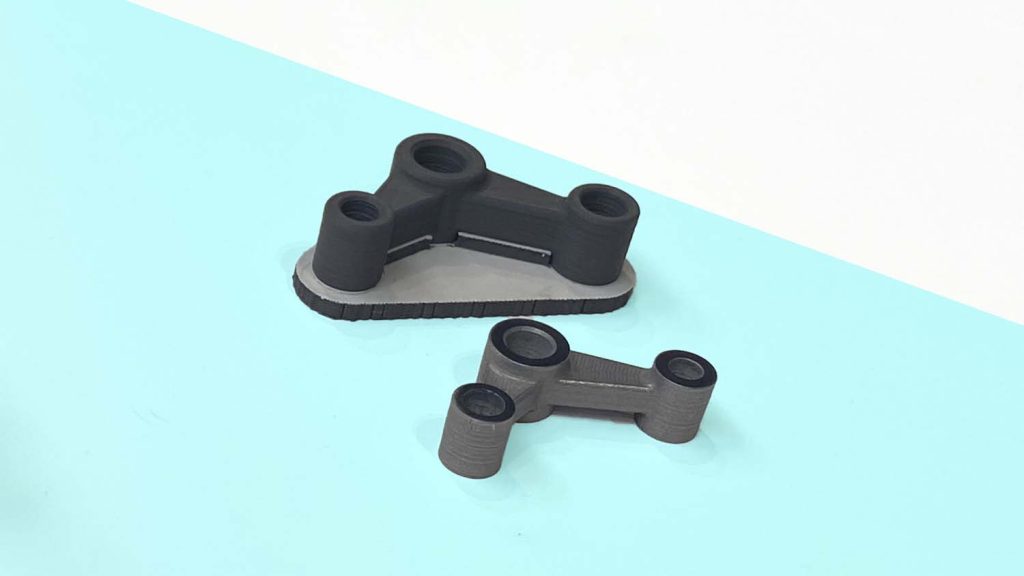Ultimaker is now offering a dedicated solution for 3D printing metal parts on the desktop using its S5 3D printer, Cura software, Ultrafuse 17-4PH material and the ceramic Ultrafuse Support Layer.
The Ultimaker Metal Expansion Kit will include all required items for metal parts preparation from printing to accessing post-processing services, including materials and a set of dedicated print cores to support both the metal filament and its support layer, allowing full design freedom.
A new Print Core DD 0.4, a highly wear-resistant core able to print the abrasive support material has been developed, but no permanent hardware modifications are needed as print cores and materials can be tapped out like any other print core or filament.
The kit includes access to exclusive Ultimaker 3D Printing Academy content that has been developed with the team from BASF Forward AM to teach the full workflow with all kinds of tips and tricks to apply Metal FDM 3D printing on the Ultimaker platform.
As the parts produced on the Ultimaker S5 desktop unit are green state, the kit also provides access to the BASF Debinding and Sintering Order Management Portal, a network of debinding and sintering services for post-processing of the 3D printed part into a full metal part.
Available in the UK, EU, North America, and China in July 2022, contents of the Kit vary by country; initially the BASF Forward AM Ultrafuse Support Layer and Ultimaker Print Core DD 0.4 will only be available in EU and UK.
“Why now? Because we’re ready with a workflow that can better than others get a user from beginning from first ever, “oh, I can print metal?!” to getting a correct part at the end of it,” explained Ultimaker CTO Miguel Calvo to DEVELOP3D.
“Working through the whole ecosystem of print preparation, settings, profiles, the education needed into ‘what is sintering? And how does it work if you’ve never done it?’. And so we wanted to come with a product that will work right first time as much as possible. Of course, there’s always things that can go wrong.
“So why now because we’ve got all those elements: we released Cura 5, brand new engine. And when we developed that engine, we worked very close to BASF, and there are specific features and functions in the engine that permits really amazing metal parts to be printed.”
Ultimaker is keen to point out that it has gone to lengths to design a full workflow for professionals, in order to achieve a working end-to-end practise. The addition of metals 3D printing on the desktop works in part due to the economics of small scale production faced by product designers, says Calvo.
He gives the example of designers needing a handful of a small parts and struggling to find a CNC house that will produce them at a reasonable cost, but more importantly take on the job in the first place.
A part that was quoted at around £200 to produce using a CNC bureau service can now be built for around £25.
Key to the desktop element is the ease and simplicity of use, with two key hurdles seemingly overcome by the addition of a ceramic support layer (reducing painful post processing), and the ease of access to a sintering service.
“We have a [piece of] £6,000 hardware – we cannot sell at £200k debinding and sintering oven – it doesn’t make sense! laughs Ultimaker product marketing manager Andrea Gasperini. “So we need to have something that aligns well, with the size and the other.
“Also, again, keep the total cost of ownership low in this case – you start with trusting the experts. Debinding is something that ing five to 10 days you get your parts back. They are the expert, they do it every day. They know what they’re doing.
“You know that if you do the printing, right for sure that the bindings in is gonna be right. In other system, you also need to be good at doing the debinding and sintering, so that’s also something that adds to failure.”
Gasperini adds that the maximum size part that can be produced is around 10-12 cm, meaning more than one part can be built on the S5 build platform. However, despite the ceramic supports, parts cannot be stacked on top of one another.
Cura 5 seems to handle a lot of the pain points, notably enabling more delicate parts, wall thicknesses and adjustments for shrinkage. “We’re investing a lot of effort and time into developing across our platform in the software, so that the application Cura; in the firmware on the machine, and in our cloud platform, the workflow that allows you to get right first time, more of the time,” adds Calvo.
As take-up grows expect to see the platform and its number of materials grow, while the time-to-return on parts reduces.
MakerBot and Ultimaker in merger ‘to accelerate’ desktop 3D Printing








